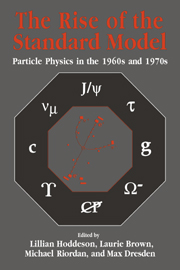Book contents
- Frontmatter
- Contents
- Contributors
- Editors' Acknowledgments
- Photographs of the Symposium
- Abbreviations and Acronyms
- Mathematical Notation
- Part One Introduction
- Part Two Quarks and Leptons
- Part Three Toward Gauge Theories
- Part Four Accelerators, Detectors, and Laboratories
- Part Five Electroweak Unification
- 23 The First Gauge Theory of the Weak Interactions
- 24 The Early History of High-Energy Neutrino Physics
- 25 Gargamelle and the Discovery of Neutral Currents
- 26 What a Fourth Quark Can Do
- 27 Weak-Electromagnetic Interference in Polarized Electron–Deuteron Scattering
- 28 Panel Session: Spontaneous Breaking of Symmetry
- Part Six The Discovery of Quarks and Gluons
- Part Seven Personal Overviews
- Index
24 - The Early History of High-Energy Neutrino Physics
Published online by Cambridge University Press: 03 February 2010
- Frontmatter
- Contents
- Contributors
- Editors' Acknowledgments
- Photographs of the Symposium
- Abbreviations and Acronyms
- Mathematical Notation
- Part One Introduction
- Part Two Quarks and Leptons
- Part Three Toward Gauge Theories
- Part Four Accelerators, Detectors, and Laboratories
- Part Five Electroweak Unification
- 23 The First Gauge Theory of the Weak Interactions
- 24 The Early History of High-Energy Neutrino Physics
- 25 Gargamelle and the Discovery of Neutral Currents
- 26 What a Fourth Quark Can Do
- 27 Weak-Electromagnetic Interference in Polarized Electron–Deuteron Scattering
- 28 Panel Session: Spontaneous Breaking of Symmetry
- Part Six The Discovery of Quarks and Gluons
- Part Seven Personal Overviews
- Index
Summary
The experiment that led to the discovery of the muon neutrino was the largest experiment that had ever been mounted at Brookhaven at its time. The experimental team consisted of only seven people – three professors, three graduate students, and one physicist from the AGS (Alternating Gradient Synchrotron) department. We fashioned the biggest detector that had ever been built at that time, consisting mainly of ten tons of aluminum. It was an experiment in which we ended up having a lot of fun and made some important progress. This chapter will discuss this experiment, the first high-energy neutrino experiment, and mention a few developments that have occurred in neutrino scattering since that time.
What was the state of particle theory in 1959, when planning for this experiment began? In general, theory was in a fairly primitive state: V–A and parity violation were well understood, and there was a general universality among weak interactions involving muons, electrons, nucleons, and neutrinos. And everything was relatively consistent with a simple four-fermion point vertex: the Fermi theory. There had been one prior neutrino experiment, done by Clyde Cowan and Fred Reines – the classic experiment, one of the most beautiful experiments of the 1950s – in which antineutrinos produced in a nuclear reactor gave rise to a reaction in which an antineutrino and a proton yielded a neutron and a positron.
- Type
- Chapter
- Information
- The Rise of the Standard ModelA History of Particle Physics from 1964 to 1979, pp. 411 - 427Publisher: Cambridge University PressPrint publication year: 1997
- 1
- Cited by



